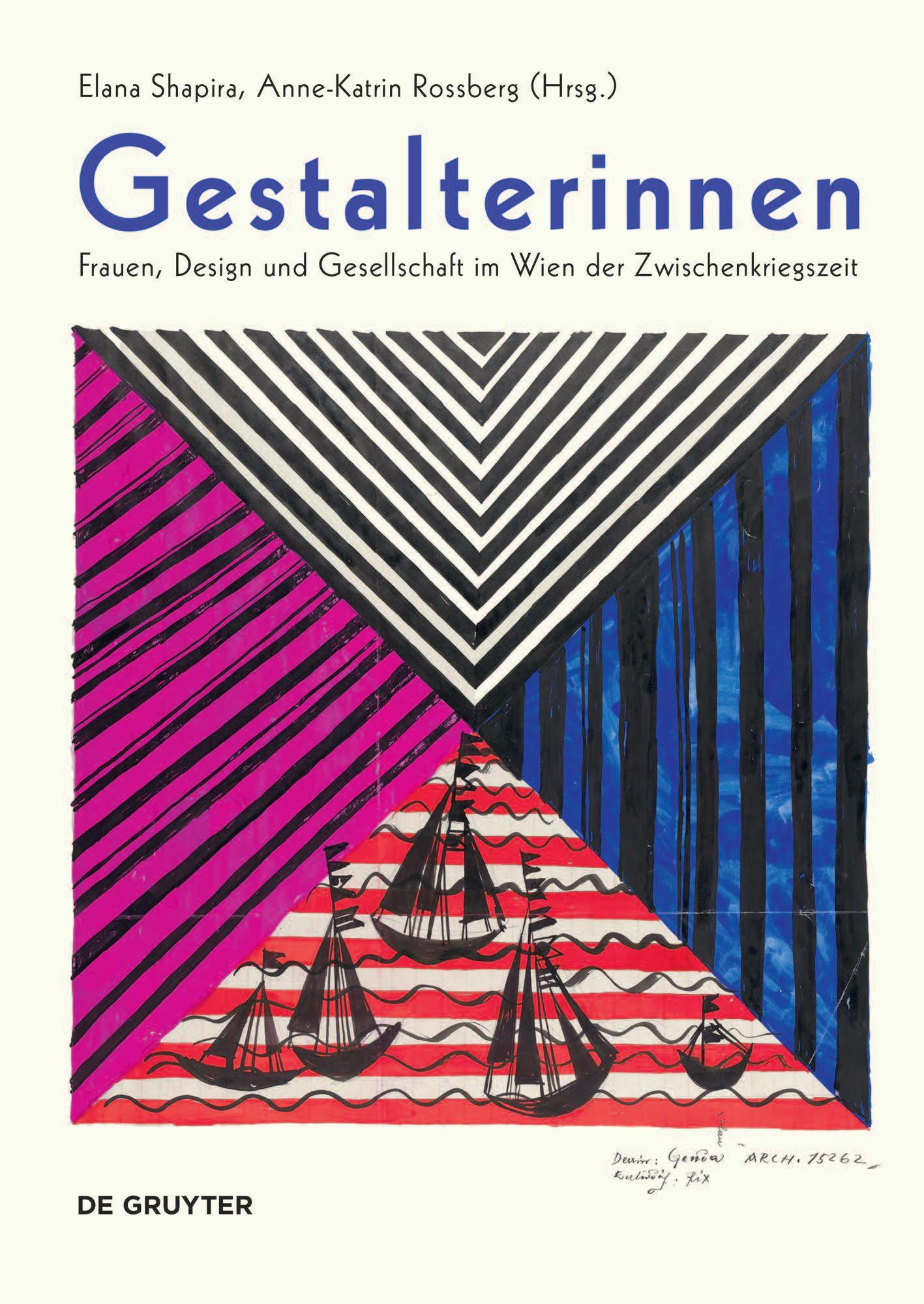PROFESSIONAL WOMEN IN THE ARTS AND MEDIA IN VIENNA –KULTUR SCHAFFENDE FRAUEN IN WIEN
And yet there is so much talent that these striving and creative women should also take an active part in the economy of our national community, and with proper support can indeed become part of it, since they are very productive and active intellectually and artistically.1
Design and Cultural Work
The book Gestalterinnen explores the important role of mostly middle-class working women in the chronicles of Viennese modernisms within the economy of production and consumption in order to show the development of interrelated women’s active participation in the culture of innovation. The contributors to this book examine how concepts of women’s professionalism evolved in the arts and media, as part of a critical aesthetic conversation in society, which is also relevant to our understanding of women’s positions in today’s culture.2 Since the mid-1990s, with the pioneering research of Sabine Plakolm-Forsthuber and later Julie M. Johnson, women’s contributions to Wiener Moderne (Viennese Modernism) began to be recognized.3 In the early 1990s, Harriet Anderson introduced an important his-
1 “Und doch ist soviel Talent vorhanden, daß diese schaffenden und schöpferischen Frauen auch nationalökonomisch gesprochen ein aktiver Teil unserer Volksgemeinschaft werden sollen und bei geeigneter Förderung werden können, da sie ja geistig und künstlerisch durchaus produktiv und aktiv sind.” Else Hofmann, “Wiener Künstlerinnen-Ausstellungen,” Die Österreicherin, vol. 1, no. 10 (December 1928), p. 4.
2 Social psychologist Marie Jahoda noted in her famous research on the unemployed in Marienthal that we should not refer to women as “unemployed” because, although they do not receive salaries, they are nevertheless working at home. Marie Jahoda et al., Marienthal: The Sociography of an Unemployed Commu nity (New Brunswick, NJ: Transaction Publishers, 2009), p. 74. See discussion in Janice Helland, “Private and Public/Studio and Venue,” in Um‑Ordnung Angewandte Künste und Geschlecht in der Moderne, eds. Cordula Bischoff and Christina Threuter (Marburg: Jonas Verlag, 1999), p. 153.
3 Sabine Plakolm-Forsthuber, Künstlerinnen in Österreich, 1897–1938 (Vienna: Picus, 1994). Plakolm-Forsthuber, “Vom Kunstgewerbe zur Innenarchitektur: Österreichische Architektinnen der Zwischenkriegszeit,” Österreichische Zeitschrift für Kunst und Denkmalpflege 42 (1988), pp. 171–79. Ingrid Brugger, ed., exh. cat. Jahrhundert der Frauen: Vom Impressionismus zur Gegenwart, Österreich 1870 bis heute (Vienna: Bank Austria Kunstforum, 1999). Critical address in Lisa Fischer and Emil Brix, eds., Die Frauen der Wiener Moderne (Vienna: Verlag für Geschichte und Politik, 1997). Other essential books on women’s participation in shaping Viennese Modernism: Julie M. Johnson, The Memory Factory: The Forgotten Women Artists of Vienna 1900 (West Lafayette, IN: Purdue University Press, 2012) and Rebecca Houze, Textiles, Fashion, and Design Reform in Austria Hungary Before the First World War (Burlington, VT: Ashgate, 2015).
9
torical contextualization of Vienna’s feminist networks and their ideologies.4 In 2008, Elke Krasny remapped Vienna by tracing the places known and less well-known women inhabited, including their histories, as she accompanied contemporary professional women on their chosen daily routes in the city.5 In 2010, Alison Rose explored the distinct perspectives of Jewish women and their critical contributions to the modernization of the city. 6 In the past decade women architects, designers, artists, and photographers have received public recognition in groundbreaking exhibitions in Vienna at the Jewish Museum (2012, 2016), the Belvedere (2019), and the MAK – Museum of Applied Arts (2021). 7 Recently, Megan Brandow-Faller and Sabine Wieber presented new research and valuable insights on women’s art and design education, organization of professional collectives, and cultural networks in the arts.8
The term “Gestalterin” is used here in order to denote the active participation of women in the arts and media as co-shapers of the cultures of modernism in Vienna. In the early twentieth century, discussions of the word referred to a number of professional women, among them talented actresses, who successfully created female roles in theater and/or film, women writers who skillfully reconstructed past realities, and fashion designers and their expert creations; mothers were also described as educators of their children.9 Within the evolution of a nationalistic rhetoric toward the end of the 1920s and in the 1930s, the word
4 Harriet Anderson, Utopian Feminism: Women’s Movements in Fin‑de Siècle Vienna (New Haven, CT: Yale University Press, 1992). Earlier exhibitions include one on feminist author Rosa Mayreder: Aufbruch in das Jahrhundert der Frau: Rosa Mayreder und der Feminismus in Wien um 1900, Vienna Museum, 1989; and one on journalist Alice Schalek: Von Samoa zum Isonzo: Die Fotografin und Reisejournalistin Alice Schalek, Vienna’s Jewish Museum, 1999.
5 Elke Krasny, Stadt und Frauen: Eine andere Topographie von Wien (Vienna: Metroverlag, 2008).
6 Jewish women’s perspectives are addressed in: Alison Rose, Jewish Women in Fin de Siècle Vienna (Austin, TX: University of Texas Press, 2010); Lisa Silverman, Becoming Austrians: Jews and Culture between the World Wars (New York: Oxford University Press, 2012); and Elana Shapira, ed., Design Dialog: Jews, Culture and Viennese Modernism (Vienna: Böhlau, 2018). Recent books and catalogues address the careers of journalist and salon hostess Berta Zuckerkandl and of reform educator, author, and salon hostess Eugenie Schwarzwald.
7 Iris Meder and Andrea Winklbauer, eds., exh. cat. Vienna’s Shooting Girls: Jüdische Fotografinnen aus Wien (Vienna: Metroverlag, 2012); Andrea Winklbauer and Sabine Fellner, eds., exh. cat. Die bessere Hälfte: Jüdische Künstlerinnen bis 1938 (Vienna: Metroverlag, 2016); and Stella Rollig and Sabine Fellner, eds., exh. cat. City of Women: Female Artists in Vienna from 1900–1938 (Munich: Prestel, 2019). There is a recent critical contribution by Anne-Katrin Rossberg and Elisabeth Schmuttermeier, eds., exh. cat. Die Frauen der Wiener Werkstätte (Basel: Birkhäuser, 2020).
8 Megan Brandow-Faller, The Female Secession: Art and the Decorative at the Viennese Women’s Academy (University Park, PA: Penn State University Press, 2020) and Sabine Wieber, Jugendstil Women and the Making of Modern Design (London: Bloomsbury, 2022).
9 There are a few selected references, for example on actresses: Fritz Blank, “Theater und Kunst: Neues Wiener Stadttheater,” Der Humorist, June 20, 1914, p. 2, or on Helene Thimig, in Moderne Welt, vol. 11, no. 20 (1930), p. 5; women’s role as “Gestalterinnen des Schicksals ihres Volkes” in Dr. F. S. “Zeitgemäße Bücher,” Frauen Briefe/Österreichische Frauenzeitung/Katholische Frauenzeitung (March 1932), p. 6.
10 E LANA S HAPIRA
“Gestalterin” was appropriated in a negative manner as defender/co-shaper of a reactionary, exclusionist worldview.10
This book reconsiders the historical construct of women as social “others” in Viennese patriarchal society by identifying the protagonists and their activities, including their collaboration within different networks, as Gestalterinnen, and shows how they tested social boundaries through their distinct aesthetic conversation. How did the upper middle-class and middle-class women’s organizational role in informal social gatherings, such as in their salons, evolve into a powerful public engagement with political movements, social reform, and organized dissent to secure a better Viennese society?11 The journalist and salon hostess Berta Zuckerkandl addressed the relationship between social integration and modern aesthetics in her supporting reviews of Secessionist artists. In her article on women’s fashion, Zuckerkandl encouraged proto-feminist consciousness by pointing out the possibilities offered to women by modern aesthetics.12 Fifteen years later, architect Otto Wagner complimented— perhaps with a note of sarcasm—the activities of Zuckerkandl as a cultural producer who had the “potential” to be a perfect minister of the arts.13 However, it is argued here that women’s active participation in the media supported the formation of the professional outlook of the Gestalterin as part of women’s collective attempts at shaping and securing pluralism in Viennese society in the interwar period.
Leading feminists Marie Lang and Rosa Mayreder contributed to the public discourse on modern architecture and art.14 Their entry as women into a discussion dominated by men also raised the question of feminism. Mayreder’s role is critical to the narratives of the Gestalterinnen of the Wiener Moderne. Following the initiative of the artist Olga Prager, and together with the Impressionist artist Tina Blau, Mayreder founded the Kunstschule für Frauen und Mädchen (Art School for Women and Girls) in 1897, which was renamed Wiener Frauenakademie (Viennese Women’s Academy) in 1926. Blau and Mayreder paved the way for these self-aware women artists, each granting the next generation the courage and the tools to
10 Dr. Josephine Widmar, “Das Problem der modernen Wohnungseinrichtung: Ein Nachwort zu verschiedenen Ausstellungen.” Reichpost, September 20, 1926, p. 6. Dr. J. Widmar, “Fasching als Kulturproblem,” Reichpost, February 9, 1925, p. 3. See Josephine Widmar biography, in German, at Litkult1920er.aau.at. On the identification of the mother as Gestalterin: “Was bedeutet die Mutter für die seelische Entwicklung des Kindes?” Die Österreicherin, no. 1 (1933), p. 3.
11 Emily Bilski and Emily Braun, eds., Jewish Women and their Salons: The Power of Conversation (New Haven, CT: Yale University Press, 2005), pp. 5–7. Further discussed in Lisa Silverman, “Ein eigenes Zimmer: Der Salon der Fotografin: A Room of Her Own: The Photographer’s Salon,” in exh. cat. Vienna’s Shooting Girls, eds. Iris Meder and Andrea Winklbauer (Vienna: Metroverlag, 2012), p. 34.
12 Berta Zuckerkandl, “Die Linie (Wie die Frau sich kleiden soll.),” Die Zeit, January 28, 1899, p. 59.
13 “Ich versichere Sie Frau Hofrat, Sie wären ein ausgezeichneter Kunstminister, Schade daß Sie es nicht sind.” O. Wagner (Vienna) to B. Zuckerkandl (Vienna), January 27, 1914, Literary Archive, Austrian National Library Vienna (LIT), B. Zuckerkandl/Sammlung Emile Zuckerkandl, Sign.: 405/B87/5.
14 Franz Arnold (pseudonym of Rosa Mayreder), “Der Wiener Styl,” Neue Freie Presse, November 9, 1898, p. 22. Franz Arnold (Rosa Mayreder), “Die Ausstellung der Secession,” Neue Freie Presse, January 17, 1899, pp. 1–3. Women were conscious that their choice of architects could help define the character of their collective as Adolf Loos’s interiors were complimented for their comfort and modernity; see G. St., “Wiener Frauen-Club,” Wiener Mode, vol. 14, no. 7, January 1, 1901, p. 295.
P ROFESSIONAL W OMEN IN THE A RTS AND M EDIA IN V IENNA – K ULTUR SCHAFFENDE F RAUEN IN W IEN 11
frequent;22 for example, a striking photograph of works by designer and teacher Emmy Zweybrück-Prochaska accompanied Zuckerkandl’s review of the Austrian Pavilion in the Deutscher Werkbund exhibition in Cologne in 1914.23
World War I prompted crises in different areas of life, specifically challenging the institution of marriage, hierarchies in families, and codes of sexual morality, and urged the rethinking of the position of women in society.24 In his 1916 book Österreichische Werkkultur, art historian Max Eisler mentioned thirty-seven Kunstgewerblerinnen (women designers) as members of the Österreichischer Werkbund (Austrian Association of the Arts) and included their addresses. Among the few women designers whose works were actually featured were the above-mentioned Zweybrück-Prochaska and Peyfuss.25 That same year the Wiener Werkstätte established the Künstlerwerkstätte (Artists’ Workshops) granting women designers new possibilities of work. Among the leading designers, Mathilde Flögl, Maria Likarz, Felice Rix, and Vally Wieselthier took part in a series of exhibitions, such as the Kunstschau 1920 in Vienna, and in high-profile and international ones such as the Exposition internationale des arts décoratifs in Paris in 1925, consequently achieving public recognition in Europe and the United States. During this time, women designers developed new techniques and ways to handle materials, incorporating influences from vernacular art, primitivism, children’s art, Rococo, East Asian art, Expressionism, and Cubism. Designers such as Harlfinger-Zakucka (graphics, children’s toys, and furniture), Wieselthier (ceramics), Maria Likarz (textiles and fashion), and Mathilde Flögl (graphics, interiors, and fashion) created idioms that were distinctive forms of modernism. Architect Adolf Loos and graphic designer Julius Klinger dismissed works by women artists of the Wiener Werkstätte as merely “decorative,” although this did not discourage the Gestalterinnen from creating an ambitious new platform for design culture. In 1926, a group of women designer-artists led by Harlfinger-Zakucka left the Association of Austrian Women Artists to found the Wiener Frauenkunst (Vienna’s Women Art) with a distinct avant-gardist agenda. Harlfinger-Zakucka published their Secessionist artistic manifesto in the journal Die moderne Frau (The Modern Woman) edited by two feminists, Else Ehrlich and Fanny Freund-Marcus.26 Their shared aim of offering a female design revolution was further supported by art critics such as Else Hofmann, who a few years later became the editor of the popular journal Österreichische Kunst (Austrian Art).
second exhibition at the Hagenbund, and Ida Mauthner reported on the exhibition for Österreichische Frauenrundschau, November, 1911.
22 A. R-r (Arthur Roessler), “Ausstellung österreichischer Kunstgewerbe 1911–1912,” Deutsche Kunst und Dekoration (1912), p. 397.
23 Berta Zuckerkandl, “Das österreichische Haus,” Deutsche Kunst und Dekoration (1914), pp. 370–71.
24 Alfred Pfoser, “Volk im Notstand. Die Sexualkatastrophe des Ersten Weltkriegs,” in exh. cat. Sex in Wien: Lust: Kontrolle: Ungehorsam, eds. Andreas Brunner, Frauke Kreutler et al. (Vienna Museum, 2016), pp. 112–
18. Pfoser reports on the increase in divorce cases, the higher rate of abortion, new discussions on masturbation, and finally, the abolition of censorship. An interesting observation is how the short hair and the short skirt developed as an imitation of the working-class women who would replace men and be hired for very low wages in the factories (ibid., p. 116).
25 Max Eisler, Österreichische Werkkultur (Vienna: Anton Schroll Verlag, 1916).
26 Brandow-Faller, The Female Secession, p. 173. On Fanny Freund-Marcus, see: Freund-Marcus, Fanny Frauen in Bewegung 1848–1938 (onb.ac.at).
14 E LANA S HAPIRA
Else Hofmann perceived her work in the media as encouraging to women designers and artists—as noted in the opening quote—to take active part in “unserer Volksgemeinschaft.”27
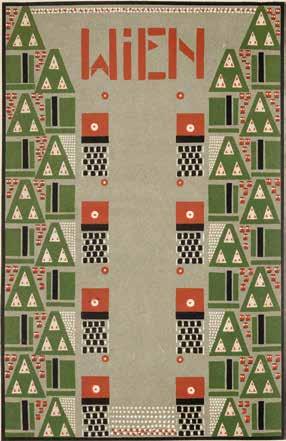
A colleague “Dr. Alma F.” (identified as Alma Wittlin-Frischauer) addressed the task of women architects, and designers specifically, to challenge the designated roles for women within a patriarchal cultural production. It was thus through their design work that they advanced women’s emancipation.28 Another prominent editor and journalist, Gisela Urban, praised the groundbreaking design of the Montessori Kindergarten in the social housing complex of Goethe-Hof (Vienna’s 22nd district) by Bauhaus students Friedl Dicker and Franz Singer. The title of her review “Kleiner Mann – was nun?” (Little Man, What Now?, 1932,) borrowed from the title of the bestselling novel by Hans Fallada, actually referred to a photograph of a young
27 This is further discussed in detail in Plakolm-Forsthuber’s chapter in this anthology. Source: Hofmann, “Wiener Künstlerinnen-Ausstellungen,” p. 4.
28 Dr. Alma F., “Die Künstlerin und ihre Stellung zur Frauenemanzipation,” Neues Wiener Journal, September 9, 1928, p. 14. Alma Wittlin-Frischauer (1899–1992) was an art historian and museologist. Her groundbreaking work as a museologist is documented in Hause der Geschichte Österreich, “Alma Wittlin erfindet ein mobiles Museum,” Hdgoe.at, https://hdgoe.at/wittlin_museum.
P ROFESSIONAL W OMEN IN THE A RTS AND M EDIA IN V IENNA – K ULTUR SCHAFFENDE F RAUEN IN W IEN 15
1 | Hilde Exner, Sketch for a poster titled Wien, in: Die Fläche, 1903
boy washing dishes, thus pointing out the potential of modernist design to challenge gender roles in society.29 Women designers’ work was considered as part of the making of Austrian design identity: the work of ceramicists Grete Neuwalder, Hertha Bucher, Lucie Rie-Gomperz, glass designer Ena Rottenberg, enamel designer Herta Mahler-Jirasko, was featured in an essay on Austrian applied arts by Swedish art historian Axel Romdahl, “Das österreichische Kunstgewerbe,” in the Deutscher Werkbund’s journal Die Form in 1930.30
The public recognition of their works strengthened women designers’ position as Gestalterinnen to relate their aesthetics to new forms of social living, as evidenced in HarlfingerZakucka’s call to arms against sober male aesthetics, published in the catalogue for the exhibition Die schöne Wand (The Beautiful Wall) organized by the Wiener Frauenkunst in 1933.31
Yet, after 1934, during the Austro-Fascist period, leading women designers such as Flögl and Zweybrück-Prochaska worked together with the conservative Neuer Werkbund Österreichs (New Werkbund Austria), cofounded by Josef Hoffmann, and were influenced by the repressive political atmosphere, supporting reframing modernist aesthetics within a reactionary and provincial rhetoric.32
Fashioning Professional Identities and Navigating Their Careers
In the process of fashioning their professional authorship as well as navigating their careers, Gestalterinnen made the best of their education, family relations, cultural networks, and memberships in professional associations. It is here argued that social class, family status, religion, ethnicity, and education were an integral part of the fashioning of professional authorities and also critical to the understanding of shifts in the careers of Gestalterinnen. Questions of identity or identification as belonging to the Jewish minority or to the Protestant minority played a critical role in the careers of women. The social worker Bertha Pappenheim was the president of the National Jewish Women’s Association in Germany for two decades and, in parallel with her travels fighting against the trafficking of women in Eastern
29 Gisela Urban, “Kleiner Mann – was nun?” Wiener Magazin (June 1935), pp. 30–31. The interior design of the Kindergarten is attributed only to Franz Singer.
30 Axel Romdhal, “Das österreichische Kunstgewerbe,” Die Form, no. 10 (1930), pp. 266–69. Rottenberg’s name is misspelled as Rothenberg.
31 F. Harlfinger, “Austellung ‘Die schöne Wand,’ Vorwort,” exh. cat. Die schöne Wand: VI. Ausstellung des Verbandes bildender Künstlerinnen und Kunsthandwerkerinnen Wiener Frauenkunst (Vienna: Österreichisches Museum für Kunst und Industrie, 1933), n. p. On Harlfinger-Zakucka’s self-assured approach to design, see Brandow-Faller, The Female Secession, p. 175. On the critical role of women designers in shaping the wall while integrating their feminine perspectives, see Rossberg’s chapter, and on Mathilde Flögl’s career, see Hölters’s chapter in this anthology.
32 On the contributions of Flögl and colleagues to Oswald Haerdtl and Josef Hoffmann’s exhibition Das befreite Handwerk, see Hölters’s chapter. On Hoffmann’s collaborations during the Austro-Fascist and Nazi period, see Elana Shapira, “‘Our Great Josef Hoffmann’: Undoing the Austrian Profile of a Celebrated Architect,” in Erasures and Eradications in Modern Viennese Art, Architecture and Design, eds. Megan BrandowFaller and Laura Morowitz (New York: Routledge, 2022). Zweybrück lectured in events organized by the Neuer Werkbund Österreich, for example “Der kulturelle Wert der Handarbeit” announced in Profil (December 1935), p. 562.
16 E LANA S HAPIRA
Europe, she gathered an impressive collection of embroidery.33 The fashion designer Emilie Flöge, whose mother, Betty Flöge and sister-in-law, Therese Flöge, were engaged in varying degrees with the Evangelical Women’s Association in Vienna, promoted modernist design aesthetics, especially through her reform dresses.34
Most Gestalterinnen were recognized authorities in their field and for long periods enjoyed successful careers as social activists, authors, and artists—notably Pappenheim, Yella Hertzka, Else Hofmann, d’Ora, Flöge, designers Harlfinger-Zakucka, Jacqueline Groag, and Wieselthier, graphic designers Lisl Weil and Marie Reidemeister, and garden architect Helene Wolf and botanist Elisabeth Boyko. Their professional projects involved cooperation with women colleagues in different fields, producing impressive results. Works by women designers were sold at a philanthropic event organized by women’s rights activist Hertzka, founder and director of a horticulture school for women, to support women in financial need (1906); and sold at another philanthropic event to raise funds for the social work project of Vienna’s “Settlement” movement, and for the New Women Club, to which leading women patrons of the Secession movement and the Wiener Werkstätte contributed, including Sonja Knips, Zuckerkandl, her sister-in-law Amalie Zuckerkandl, and Lili Waerndorfer (1907).35
The multifaceted character of Gestalterinnen’s creative cooperation can be compared to the description of producing performances of Ausdrucktanz (expressive dance or free dance) that included writers, composers, costume designers, photographers, and artists. 36 In our anthology, we encounter the fruitful collaborations between women cultural producers, businesswomen, applied artists, dancers, and photographers, such as d’Ora’s series of portraits of patron Pauline von Metternich37 and of fashion designer Emilie Flöge. The reportage photographer Marianne Blumberger, married to the psychiatrist Edmund Bergler, was identified as the “in-house photographer” of the journal Die Bühne. Her photographs were reproduced in almost every issue of this journal in the 1920s and 1930s, including one of ceramicist Wieselthier observed at work.38 It is further assumed that Marianne Blumberger mediated or arranged the first major exposure of her young and unknown sister-in-law, the designer Hilde Blumberger—alias Jacqueline Groag—in this journal in 1931.39
33 On the charismatic Pappenheim and her collection, see Völker’s chapter.
34 On Flöge’s cultural networks, see Krautgartner’s chapter in this anthology.
35 On the philanthropic events organized by Pauline von Metternich, Hertzka, and the patrons of the Wiener Werkstätte, see Sophie Lillie’s chapter in this anthology. On the critical role of feminist and cofounder Marie Lang and especially of the role of Else Federn, the director of the association Verein Wiener Settlement, see Inge Podbrecky, “Reform bauen: Netzwerke und Bauten des Wiener Settlement-Vereins: Architektonische Moderne als Ausdruck einer integrativen Identität,” Wiener Geschichtsblätter, no. 4 (2020), pp. 323–38.
36 Andrea Amort, “Free Dance in Interwar Vienna,” in Interwar Vienna: Culture between Tradition and Mo dernity, eds. Debora Holmes and Lisa Silverman (Rochester: Camden House, 2009), p. 117.
37 Atelier d’Ora’s photograph of Pauline Metternich-Sándor, ca.1903 (Museum für Kunst und Gewerbe Hamburg). On d’Ora’s role in shaping the professional image of her sitters, see Magdalena Vuković’s chapter in this anthology.
38 See Blumberger and Schulz’s photograph in “Die Frau macht sich als Mann sehr gut,” Die Bühne, no. 230 (1929), p. 39.
39 “Eine Kunstgewerblerin richtet sich ein,“ Die Bühne, no. 317 (1931), pp. 18–19. The photographs of Hilde Blumberger were taken by Otto Skall (1884–1942). See discussion in Ursula Prokop’s chapter in this anthology.
P ROFESSIONAL W OMEN IN THE A RTS AND M EDIA IN V IENNA – K ULTUR SCHAFFENDE F RAUEN IN W IEN 17
Photography and media exposure played a critical role in promoting women’s careers. Journalists and photographers skillfully harmonized professional women’s self-representation with contemporary culture, and as a result literally supported women’s authorships and shaped shared cultures, as documented in d’Ora’s photograph of Emmy Zweybrück-Prochaska in 1915. D’Ora depicts the designer sitting with a determinedly serious expression, dressed in an elegant white shirt, dark waistcoat, and skirt with a striking striped pattern, holding a fan (fig. 2). At that time Zweybrück-Prochaska was promoting her art school for girls (fig. 3).40 Zweybrück and Wieselthier successfully ran their own workshops (fig. 4).41 Wieselthier also published articles defining her professional and creative ideology. Photographs of Wieselthier’s ceramics and of herself, featured as a celebrity designer, appeared in different journals. Thus, photography granted women the possibility of securing their artistic claims. While
40 J. K., “Die Kunstschule von Emmy Zweybrück–Wien,” Deutsche Kunst und Dekoration (July 1915), pp. 279–82. 41 Wieselthier opened her own workshop in 1922 and sold it to the Wiener Werkstätte in 1928. On Wieselthier, see Shapira’s chapter. Zweybrück opened her workshop in 1913 and her School of Art and Craft for girls in 1915; see Paul Klobučar, “Emmy Zweybrück, ihre Werkstätte und ihre Schule,” Deutsche Kunst und Dekoration (October 1918), pp. 97–104; Karl Maria Grimme, “Aus der Werksätte einer Frau,” Moderne Welt, vol. 11, no. 9 (1930), pp. 16–17. On Zweybrück’s progressive approach to art pedagogy, see Megan BrandowFaller, “From Secessionist Vienna to Postwar America: Emmy Zweybrück-Prochaska and the Cult of Creativity” in Erasures and Eradications in Modern Viennese Art, Architecture and Design, pp. 158–63.
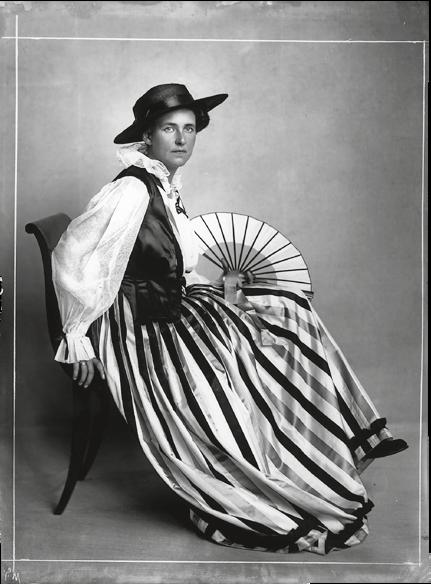
18 E LANA S HAPIRA
2 | d’Ora, Emmy ZweybrückProchaska, 1915
d’Ora captured the artistic call of the modernist dancer, Anita Berber, in the early 1920s, her former assistant Trude Fleischmann helped shape the public profile of another avant-gardist dancer, Claire Bauroff, showing her as a strong-willed performer in the mid-1920s.42 There were Gestalterinnen who positioned themselves in different ways in relation to their successful modernist partners: Emilie Flöge in relation to the Secessionist Klimt, Harlfinger-Zakucka in relation to her husband artist Richard Harlfinger, and garden architect Anna Plischke in relation to her husband architect Ernst A. Plischke.43 Others, like Hilde Blumberger, who changed her name after forced emigration to Jacqueline Groag to fit her partner’s name, architect Jacques Groag, surpassed him with her success in Britain. She skillfully translated her Viennese modernist formal language, including childlike and geometric decorative patterns, to fit contemporary British aesthetic conversation.44 Otto Neurath, philosopher of science and director of the Museum of Society and Economy, established together with his partner and later wife, graphic designer Marie Reidemeister, an interdisciplinary team called “Vienna Method of Image Statistics” (later Isotype). After their forced emigration to Britain
42 On d’Ora supporting Anita Barber’s professional claim as an artist, see Vuković’s chapter.
43 Discussions on Flöge and Klimt in Krautgartner’s chapter, on Harlfinger-Zakucka in Brandow-Faller’s chapter, and on Plischke in Ulrike Krippner’s chapter.
44 On the successful career of Jacqueline Groag after her forced emigration to Britain, see Prokop’s chapter.
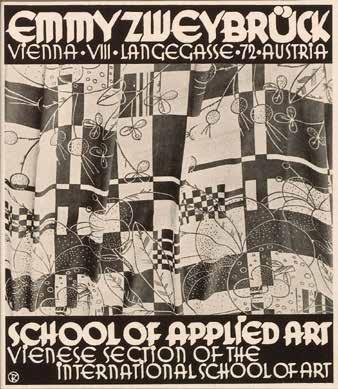
P ROFESSIONAL W OMEN IN THE A RTS AND M EDIA IN V IENNA – K ULTUR SCHAFFENDE F RAUEN IN W IEN 19
3 | Rudolf Köhl, Business card for Emmy Zweybrück’s School of Applied Art, late 1920s
and Neurath’s early death, Reidemeister continued to explore and demonstrate the creative possibilities of visual education.45 The relationship between these couples was not one of dependency but of creative cooperation as part of progressive cultural networks that flourished in the interwar period and continued in most cases after their forced emigration.46
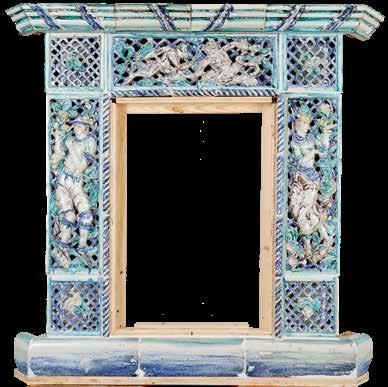
Within a patriarchal and hierarchical world several women proved their ability to develop and sustain their professionalism and, furthermore, to handle their financial affairs. They created their own spaces, homes, studios, schools, and exhibitions, where they could negotiate and establish to different degrees their distinct creative authorship. Among the Gestalterinnen who chose to remain single or did not marry—such as Flögl, Wieselthier, d’Ora, Pappenheim, and Hofmann—and succeeded in maintaining their careers, professional initiatives and adaptability to changing circumstances were required. Pappenheim and Hertzka were shrewd in expanding their women’s networks in order to advance their social and political activities. Flögl applied her skills in different design projects initiated by Josef Hoffmann and established her authorship as a teacher in different trade schools.
45 On Reidemeister’s productive and creative collaboration with Neurath, see Christopher Burke and Günther Sandner’s chapter in this anthology.
46 For further discussions on the critical role of cultural networks in designers’ careers, see BrandowFaller’s, Rossberg’s, Prokop’s, Plakolm-Forsthuber’s, and Krippner’s chapters in this anthology.
20 E LANA S HAPIRA
4 | Vally Wieselthier, Fireplace casing, Wieselthier Workshop, c. 1925
Hofmann successfully claimed her authorship as an art critic in Vienna and after her forced emigration in New York. In Vienna she cooperated with Ella Zirner-Zwieback, owner of a leading fashion store, and with architect Liane Zimbler, on different exhibition projects. 47 Photographs of Zirner-Zwieback, Hofmann, and Zimbler were published in journals in part to assert their professional authorships. Zimbler collaborated closely with Harlfinger-Zakucka as designer of the Wiener Frauenkunst avant-gardist exhibitions. For the textile designs in her interiors, Zimbler hired Maria Likarz.48
The careers of many Jewish Gestalterinnen, including Zimbler, Hofmann, Blumberger, and Hertzka, were brutally interrupted after the so- called Anschluss of Austria to Nazi Germany in 1938. They were forced to emigrate and survived in exile. Several colleagues, including Friedl Dicker (later married Brandeis), were murdered in the Holocaust. Those who were not persecuted, including Flöge, Harlfinger-Zakucka, Hilda Jesser, and Flögl, remained in Austria and were affected in different ways by Nazi rule and the hardship of World War II.
Vienna’s Gestalterinnen— Aesthetic Conversation and Social Reform
The book is divided into three parts that address different aspects of the contributions of the Gestalterinnen to the Viennese cultures of modernism. The first part, “Avantgardistinnen der Wiener Moderne” (Avant-garde Women of Viennese Modernism,) explores their productions and careers as an integral part of the leading forces shaping Viennese Modernism. The second part, “Weibliche Entwürfe von Emanzipation” (Women’s Designs of Emancipation,) shows how women designers, dancers, photographers, and journalists successfully grafted their and other women’s symbolic and real liberation. The third part, “Kulturarbeit und politisches Engagement” (Cultural Work and Political Engagement,) shows how the achievements of the pioneer Gestalterinnen were directly related to pushing forward social agendas and expanding cultural work.
I. Avantgardistinnen der Wiener Moderne
The first part of the book explores the different ways creative personalities, such as the cultural producer Pauline von Metternich, the fashion designer Flöge, and a group of Wiener Werkstätte multitalented designers including Harlfinger-Zakucka, Likarz, and Flögl, critically contributed to new aesthetic conversations and cocreated the Viennese avant-garde.
Sophie Lillie describes in “Fürstin Paulines Frühlingsfeste: Weibliche Wohltätigkeit auf dem Weg zur Wiener Moderne,” how cultural events served to popularize modern aesthetics and at the same time serve the social agenda. A series of spring festivals lasting several days, organized by Princess Pauline at the turn of the century, among them the “Rainbow-Pergola” (1898), “Secessionist Village” (1899), and the “Japanese Cherry Blossom Festival” (1901) served
47 On the cooperations between Hofmann and Zimbler and Hofmann and Zirner-Zwieback, see Plakolm-Forsthuber’s chapter.
48 On creative collaborations between women designers, see Rossberg’s chapter.
P ROFESSIONAL W OMEN IN THE A RTS AND M EDIA IN V IENNA – K ULTUR SCHAFFENDE F RAUEN IN W IEN 21
Maria Likarz übernahm in der Wohnung Bauer die Bemalung des Schlafzimmers, das einmal mehr die von Hoffmann so geschätzte zeltförmige Decke aufwies.19 Der Eindruck eines Zeltes wurde noch gesteigert durch einen von Gabriele Hackl bemalten Seidenvorhang, der die gesamte Fensterwand einnahm. Der Typus des (mit Textilien gestalteten) Zeltzimmers hatte sich um 1800 etabliert und in der Folge vor allem Damen- und Toilettezimmer als private, intime Räumlichkeiten charakterisiert.20 Das Schlafzimmer der Wohnung Bauer diente jedoch auch als Wohnraum, es war mit einem Schrankbett ausgestattet und enthielt eine Sitzecke mit Kamin, gefertigt von der Keramikerin Hertha Bucher. Die Arbeiten aller drei Künstlerinnen nahmen aufeinander Bezug; Linien und Flächen mit eingestreuten Bildmotiven waren bestimmend. Ludwig Steinmetz sah in der Wohnung Bauer das „Problem der farbigen Wohnräume“ neuartig gelöst und ließ dabei deutlich werden, was den vielfältigen Einsatz der Wandgestaltung im Wiener Interieur verständlich macht: Man wollte auf keinen Fall „die Nüchternheit bloßer Zweckform“.21 Dies war dem Bauhaus oder dem Deutschen Werkbund vorbehalten, in Wien antwortete man auf Sachlichkeit mit Sinnlichkeit, Humor und schönem Schein, worin auch die WW-Künstlerinnen ausgebildet waren.22
Spezialistinnen
Drei von ihnen haben sich hinsichtlich der Wandgestaltung besonders hervorgetan: Mathilde Flögl (1893–1958), Hilda Jesser (1894–1985) und Maria Likarz (1893–1971).23 Sie experimentierten mit Materialien und Techniken und beschäftigten sich zum Teil noch lange nach dem Konkurs der WW 1932 mit dem Thema – im Falle von Jesser auch als Leiterin der Fachklasse für angewandte Malerei an der Wiener Kunstgewerbeschule.
Nach der Wohnung Bauer involvierte Josef Hoffmann Mathilde Flögl erneut in zwei seiner Aufträge; diesmal ging es um ein Geschäftslokal und ein Kaffeehaus. In der Filiale der Schoko-
WWTAMB 17. Siehe auch Rudolf Haybach, Neue Arbeiten der Wiener Werkstätte. Salubra Wandbekleidungen, in: Deutsche Kunst und Dekoration, 65, 1929/30, S. 274–276.
19 Hoffmann setzte das Zeltdach bereits in seiner frühen Ausstellungsarchitektur ein, allerdings zunächst aus pragmatischen Gründen, vgl. Sabine Plakolm-Forsthuber, Moderne Raumkunst. Wiener Ausstellungsbau ten von 1898 bis 1914, Wien 1991, S. 66, 152.
20 Vgl. Anne-Katrin Rossberg, Das angekleidete Zimmer. Zum Negligéstil im Interieur, in: Das doppelte Kleid. Zu Mode und Kunst, hrsg. von Susanne Neuburger u. a., Ausst.-Kat. Galerie Schloss Ottenstein, Wien 1996, S. 43–45.
21 Steinmetz 1927/28 (wie Anm. 17), S. 446.
22 An dieser Stelle sei darauf hingewiesen, dass am Bauhaus die Wandmalerei als männliches Betätigungsfeld definiert wurde und Frauen in der entsprechenden Werkstätte kaum zugelassen waren. Vgl. Morgan Ridler, Dörte Helm, Margaret Leiteritz, and Lou Scheper-Berenkamp: Rare Women of the Bauhaus Wall-Painting Workshop, in: Elizabeth Otto u. a. (Hrsg.), Bauhaus Bodies: Gender, Sexuality, and Body Culture in Modernism’s Legendary Art School, New York 2019, S. 195–216. Eine genaue Analyse der unterschiedlichen Zugänge zum Thema Wandmalerei in Wien und Dessau steht noch aus.
23 Zu den Biografien der Künstlerinnen siehe Ausst. Kat. Wien 2020 (wie Anm. 1), S. 216–217, 231, 239–240. Hilda (auch Hilde) Jesser war ab 1924 mit Hubert Schmid verheiratet und schien fortan als Schmid(t)-Jesser oder Jesser-Schmid(t) auf; Maria Likarz heiratete 1920 den Arzt Richard Strauss und nannte sich Strauss-Likarz, Likarz-Strauss, Strauhs-Likarz und zuletzt nur noch Strauss. Der Einfachheit halber werden in diesem Text die Geburtsnamen verwendet.
88 A NNE -K ATRIN R OSSBERG
7
27, 1928, S. 468
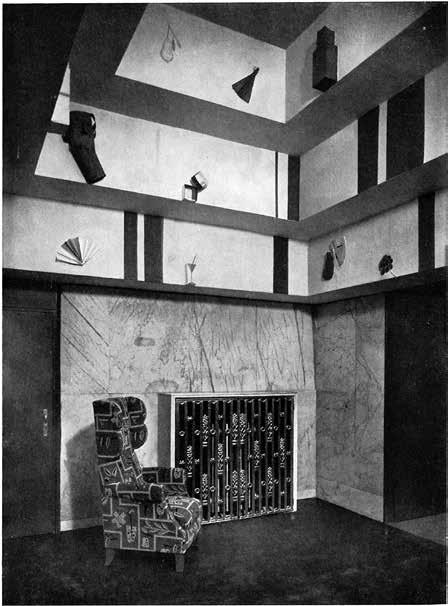
ladenfirma Altmann & Kühne, Kärntner Straße 36, bemalte Flögl die zeltförmige Decke (die hier dazu diente, das kleine Ecklokal großzügiger wirken zu lassen) mit Darstellungen von Früchten, Bonbongläsern und Konfektschachteln.24 In der Bar des Graben-Cafés übersetzte sie die Malerei in Papiermaschee und ließ die Motive dadurch in den Raum wachsen (Abb. 7). Mithilfe farbiger Streifen erhielten sie innerhalb der abgestuften Decke Rahmung und Struktur. Dieses grafische Konzept erinnert an den von Flögl gestalteten Jubiläumskatalog zum 25-jährigen Bestehen der WW, der wie die Interieurs 1928 entstand.25
Für die große Werkbund-Ausstellung, die 1930 im ÖMKI stattfand, kreierte die Künstlerin einen eigenen Raum – eine viel beachtete Likörstube, deren Wände aus Wellpappe bestanden. Die Rezeption reichte bis in die USA: „It is of course the most modern of modernistic rooms – being done in blue and rose and equipped with most luxuriously comfortable chairs and stools and little tables placed in just the right spots.“26 Bei all der Aufmerksamkeit, die der Raum erzeugte, verwundert es, dass (trotz umfassender Fotodokumentation der Ausstellung) keine Abbildung überliefert ist. Wurde Flögl in ihrer Rolle als Architektin hier am Ende nicht
24 Abb. in: Moderne Bauformen, 27,1928, S. 466–467.
25 Abb. in: Ausst. Kat. Wien 2020 (wie Anm. 1), S. 9.
26 U. S. Women Attend Vienna Art Exhibition, in: The Chicago Tribune, 17.6.1930, S. 9. Dank an Claudia Cavallar für diesen Hinweis.
E IN NEUES E XPERIMENTIERFELD 89
| Mathilde Flögl, Wandgestaltung in der Bar des Graben-Cafés, 1928, in: Moderne Bauformen,
ernst genommen, auch in Hinblick auf das provisorische Material Papier? Dem widerspricht zumindest eine Rezension, in der sie neben ihren Kollegen Hoffmann, Haerdtl, Frank, Strnad, Wimmer, Holzmeister, Witzmann und anderen als Beteiligte an der architektonischen Gesamtleistung hervorgehoben wird: „Man sieht: es sind die besten Namen der älteren Generation und des Nachwuchses, die sich hier vereinigt finden.“27
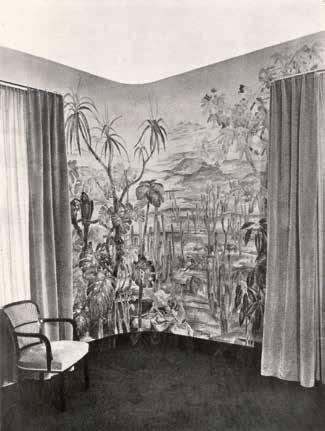
Auch aus heutiger Sicht sticht Mathilde Flögl als eine Künstlerin hervor, die der Wandgestaltung neue Impulse verlieh: mit der Verschränkung von grafischen und plastischen Elementen sowie dem Einsatz ungewöhnlicher Materialien. Dabei blieb sie ihrer in der WW entwickelten Bildsprache treu.28
Anders stellt es sich bei Hilda Jesser dar. Ihr war es wichtig, der Funktion des Raumes zu folgen und darüber hinaus dessen Wirkung zu steigern. So entstanden die vielfältigsten Wandgestaltungen je nach Bauaufgabe. Gemeinsam mit Karl Witzmann, dessen Assistentin sie 1922 an der Kunstgewerbeschule wurde, schuf Jesser den Mittelraum der Kunsthandwerk- und Peche-Gedächtnisausstellung im ÖMKI 1923. Leitmotiv ihrer Malereien waren
90 A NNE -K ATRIN R OSSBERG
27 Wolfgang Born, Der Werkbund stellt aus, in: Die Bühne, H. 282, 1930, S. 29.
28 Zu Flögls weiterem Werdegang siehe den Beitrag von Michael Hölters in diesem Sammelband.
8 | Hilda Jesser, Wandmalerei im Speisezimmer des Hauses Hériot, 1930, in: Innendekoration, 42, 1931, S. 12
hellgelbe Vorhänge,29 deren Muster an das Peche-Dessin Kardinal erinnern. Damit erwies sie ihre Referenz gegenüber dem früh verstorbenen Künstlerkollegen und bereitete zugleich eine Bühne – Vorhang auf! – für die aktuellen Produkte des österreichischen Designs. In derselben Ausstellung war ein Speisezimmer von Wilhelm Jonasch zu sehen, „das Hilde Jesser durch graziöse Wandbemalung in einen entzückenden Gartensalon verwandelt hatte“.30 Spaliere mit Rankpflanzen, Vögeln und Schmetterlingen gaben den Blick in eine asiatisch anmutende Landschaft frei. Der Raum stellte damit ein Beispiel für die in den 1920er-Jahren so beliebten Chinoiserie-Motive im Interieur dar; zugleich erinnern die Spaliere an die BerglZimmer in Schloss Schönbrunn.
Gänzlich in Landschaft aufgelöst zeigte sich das Speisezimmer in der Pratervilla von Hilde und Auguste Hériot, die 1930 von Fritz Reichl umgebaut wurde. Hier blickte man in eine weite südamerikanische Berglandschaft mit exotischen Pflanzen und Tieren im Vordergrund (Abb. 8). Interessanterweise ist generell das Speisezimmer vielfach Ort solcher an die Panoramatapeten des frühen 19. Jahrhunderts erinnernden Malereien. Sie dienten womöglich der Repräsentation der kosmopolitischen Bewohner*innen gegenüber ihren Gästen oder einfach der Unterhaltung beim gemeinsamen Essen.
Als Hauptwerk Jessers können die noch erhaltenen Wandmalereien in einem der Musikstudios des Wiener Funkhauses gelten.31 Clemens Holzmeister, Architekt des Gebäudes, hatte Jesser 1937 als Gestalterin vorgeschlagen, 1939 wurden die Arbeiten ausgeführt. Dazwischen lag der „Anschluss“ Österreichs an NS-Deutschland, der für Hilda Jesser die Zwangspensionierung an der Kunstgewerbeschule zur Folge hatte. Begründet wurde diese Maßnahme damit, dass sich ihre „Tätigkeit als Lehrkraft im kunsterzieherischen Sinn mit den Richtlinien der Kunstbewegung der NSDAP nicht vereinigen lässt“.32 Dessen ungeachtet konnte sie die Funkhaus-Malereien ausführen, deren Inhalte – eine Aulandschaft mit verschiedenen Figuren- und Tiergruppen – am Ende unbedenklich erschienen (Abb. 9). Bildaufbau und Malweise, die an Paul Cézanne erinnern, sowie Motive, die an Marc Chagall und Henri Matisse denken lassen, entsprechen dabei so gar nicht den NS-Kunstidealen. Bewusst intendiert war dies jedoch nicht.33 In einem umfangreichen Artikel beschreibt Jesser vor allem die besondere Herausforderung durch die vorgegebene Architektur sowie ihre Überlegungen zum Sujet:
29 Hans Ankwicz, Ausstellung von Arbeiten des modernen österreichischen Kunsthandwerks, in: Deut sche Kunst und Dekoration 54, 1924, S. 19–25, hier S. 19. Zeitgenössische Fotografien siehe https://sammlung.mak.at/sammlung_online?&q=jesser kunsthandwerk raum I (7.8.2022).
30 Ebd., S. 20. Zeitgenössische Fotografien siehe https://sammlung.mak.at/sammlung_online?&q=jesser kunsthandwerk jonasch (7.8.2022).
31 Am 2.7.2022 strahlte der Radiosender Ö1 eine Diagonal Spezial-Sendung zum Thema Funkhaus aus. Siehe Hilda Jessers Wandmalereien im Wiener Funkhaus – oe1.ORF.at (7.8.2022).
32 Personalakt Hilda Schmid-Jesser, Universität für angewandte Kunst, Kunstsammlung und Archiv.
33 Nach der für sie völlig unverständlichen Zwangspensionierung suchte Jesser die Unterstützung von NS-Staatssekretär Kajetan Mühlmann, um den Funkhaus-Auftrag ausführen zu können. In einem Schreiben verwehrt sie sich gegen den Vorwurf, einer „entarteten Kunstrichtung“ zu folgen und betont ihre politische Integrität als „Vollarierin“. Österr. Staatsarchiv Akt R.St. III 201.072-38. Dank an Sabine Plakolm-Forsthuber für diesen Hinweis. Jessers Rolle während der NS-Zeit wird derzeit genauer untersucht.
E IN NEUES E XPERIMENTIERFELD 91
Das Problem dieser sehr interessanten Aufgabe war, die vielen, teilweise sehr schmalen Felder von einer immerhin beträchtlichen Höhe in einer großzügigen Lösung zusammenzufassen. Die herbe Strenge der Lisenen war bestimmend für die Komposition. Als Thema wählte ich mit Absicht eine einfache Aulandschaft. Der Saal ist ein Arbeitsraum, und die dekorative Lösung der Wände darf thematisch den darin Verweilenden nicht in Anspruch nehmen, sondern sie hat die Aufgabe, Atmosphäre zu schaffen, den Raum angenehm zu gestalten.34
Derselbe Artikel in der Innendekoration bildet auch eine Stuckarbeit Jessers ab – gemeinsam mit dem Sgraffito eine weitere Spezialdisziplin der Künstlerin. Mit Stuck gestaltete sie in den 1930er-Jahren Deckenmotive in der Wiener Sandleitenkirche, im Café Imperial und im Kasino Baden; ein großes Sgraffito fertigte sie etwa für den österreichischen Ausstellungspavillon auf der Pariser Weltausstellung 1937. Insgesamt reicht die Qualität dieser Arbeiten nicht an ihre Malereien heran, es ist jedoch gänzlich unbekannt und deshalb hervorzuheben, wie gefragt Jesser als Stuckkünstlerin war – während der NS-Zeit und bis weit in die Jahre des Wiederaufbaus hinein.35

34 Schmid-Jesser 1940 (wie Anm. 8), S. 120.
35 Während des Krieges schuf Jesser Stuckarbeiten und Wandmalereien für das Ständehaus Saarbrücken. Dieses wurde von Otto Niedermoser adaptiert, womöglich im Auftrag des Wiener Gauleiters Josef Bürckel, dessen Saarbrückener Haus er einrichtete. Nach dem Krieg entwarf sie Dekore für Burgtheater (Otto Niedermoser/Michael Engelhart) und Staatsoper (Erich Boltenstern), schuf Stuckdecken für das Gewerbehaus (Carl Appel), das Salzburger Hotel Mirabell (Max Fellerer), das Innsbrucker Stadttheater (Boltenstern) sowie
92 A NNE -K ATRIN R OSSBERG
9 | Hilda Jesser, Wandmalerei im Musikstudio des Funkhauses Wien, 1939
Auch Maria Likarz war eine geschätzte Wandgestalterin, mit der Architekten wie Architektinnen gleichermaßen kooperierten. Else Hofmann widmete ihr 1931 einen Artikel unter dem Titel Die Malerin Maria Strauß Likarz 36 Begleitet wurde er von einer umfangreiche Bildstrecke, die die Vielseitigkeit der Künstlerin auch in den Textil-, Leder-, Email- und grafischen Arbeiten für die Wiener Werkstätte wiedergab. Besonders hervorgehoben wurden jedoch ihre Wandmalereien, „in denen sie eine einzigartige, liebenswürdige Spezialität darstellt“, so Hofmann mit Hinweis auf den Gelben Saal der Kaiserbar (1925/26) und die Erholungsräume der Textilfirma Bernhard Altmann (1928).37 Für den Gelben Saal hatte Likarz ursprünglich eine arkadische Landschaft vorgesehen (Abb. 10), folgte dann jedoch der schon erwähnten Chinoiserie-Mode.38 Für die Firma Altmann schuf sie monumentale Landkarten, deren übermütiger Humor kaum seinesgleichen finde, schwärmte die Rezensentin, um abschließend festzustellen, dass es kühnere Schöpfungen gebe als die von Likarz, „aber kaum gekonntere und reizendere“.39 Dieses Können zeigte sich sowohl in der Technik als auch in der Bilderfindung, die auf Architektur und Raumfunktion subtil einging. Ein herausragendes Beispiel ist
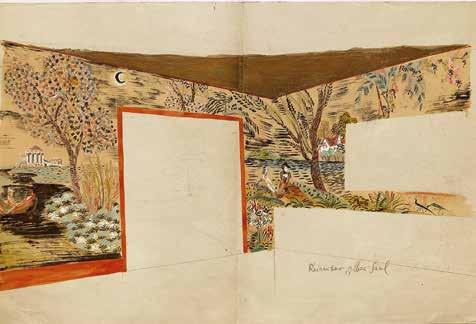
diverse Arbeiten für das Hotel Bristol in Wien etc. Abbildungen weiterer Stuckarbeiten siehe https://sammlung.mak.at/sammlung_online?&q=jesser stuck* innsbruck (7.8.2022).
36 Else Hofmann, Die Malerin Maria Strauß-Likarz, in: Deutsche Kunst und Dekoration, 68, 1931, S. 48–64. Zu Else Hofmann siehe den Beitrag von Sabine Plakolm-Forsthuber in diesem Sammelband.
37 Ebd., S. 61.
38 Vgl. zeitgenössische Fotografie im MAK, NLML 39.
39 Hofmann 1931 (wie Anm. 36), S. 64. An dieser Stelle weist Hofmann auch auf Likarz’ WW-Präsentationen in Düsseldorf (vermutlich Deutsche Raumkunst 1928) und die PRESSA in Köln (ebenfalls 1928) hin;
E IN NEUES E XPERIMENTIERFELD 93
10 | Maria Likarz, Entwurf für die Wandmalerei im Gelben Saal der Kaiserbar, 1925/26
